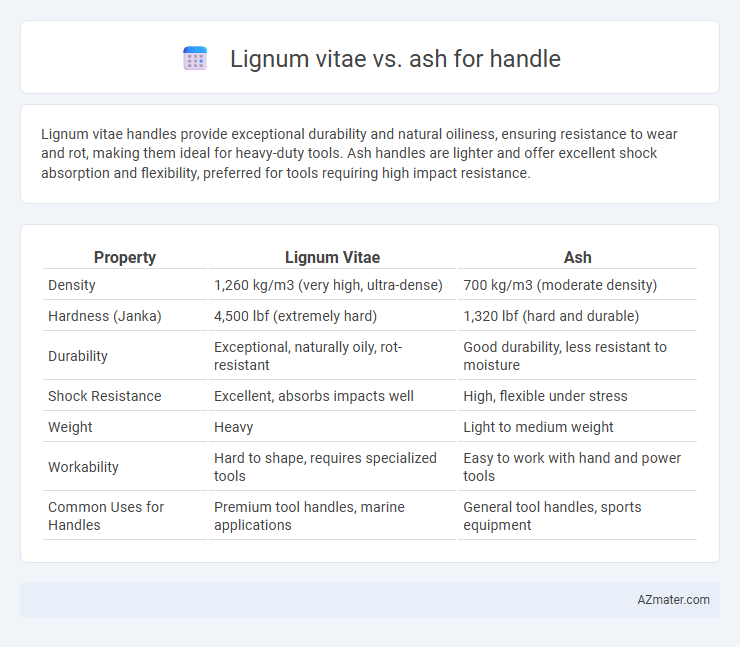Lignum vitae handles provide exceptional durability and natural oiliness, ensuring resistance to wear and rot, making them ideal for heavy-duty tools. Ash handles are lighter and offer excellent shock absorption and flexibility, preferred for tools requiring high impact resistance.
Table of Comparison
| Property | Lignum Vitae | Ash |
|---|---|---|
| Density | 1,260 kg/m3 (very high, ultra-dense) | 700 kg/m3 (moderate density) |
| Hardness (Janka) | 4,500 lbf (extremely hard) | 1,320 lbf (hard and durable) |
| Durability | Exceptional, naturally oily, rot-resistant | Good durability, less resistant to moisture |
| Shock Resistance | Excellent, absorbs impacts well | High, flexible under stress |
| Weight | Heavy | Light to medium weight |
| Workability | Hard to shape, requires specialized tools | Easy to work with hand and power tools |
| Common Uses for Handles | Premium tool handles, marine applications | General tool handles, sports equipment |
Introduction: Lignum Vitae vs Ash for Tool Handles
Lignum Vitae offers exceptional density and natural oils that provide superior durability and resistance to wear, making it ideal for heavy-duty tool handles. Ash, known for its lightweight flexibility and excellent shock absorption, delivers comfort and resilience under extended use. Choosing between Lignum Vitae and Ash depends on balancing the need for toughness with ergonomic handling in tool design.
Overview of Lignum Vitae Properties
Lignum vitae is a dense, self-lubricating hardwood known for its exceptional hardness, natural oils, and resistance to water and wear, making it ideal for durable handles exposed to moisture. Its high density (approximately 1.23 g/cm3) provides superior strength and longevity compared to ash, which is lighter and less dense. The natural resin content in Lignum vitae also offers antimicrobial properties and low friction, enhancing grip and comfort in handle applications.
Characteristics of Ash Wood Handles
Ash wood handles are highly valued for their exceptional strength-to-weight ratio, providing durability without excessive heaviness, making them ideal for tool and weapon grips. Their straight grain and coarse texture offer excellent shock absorption and a secure, comfortable grip, enhancing user control during extended use. Compared to Lignum vitae, ash handles are lighter and easier to shape, though they lack the extreme density and natural oiliness that make Lignum vitae highly resistant to wear and moisture.
Durability and Strength Comparison
Lignum vitae, known for its exceptional density and natural oils, offers superior durability and strength compared to ash, making it highly resistant to wear and impact. Ash wood, while lighter and moderately strong, lacks the natural lubrication properties of lignum vitae, resulting in less resistance to cracking and splitting under heavy use. The high Janka hardness rating of lignum vitae, typically around 4,500 lbf, significantly exceeds ash's 1,320 lbf, confirming its dominance in applications demanding maximum handle durability and strength.
Weight and Balance in Tool Handles
Lignum vitae, known for its exceptional density of about 1.23 g/cm3, offers a significantly heavier handle compared to ash, which has a density around 0.60-0.75 g/cm3, contributing to superior weight in tool handles for enhanced control and durability. The higher weight of lignum vitae improves balance by providing a solid, stable grip that reduces vibration and user fatigue during prolonged use. Ash, being lighter and less dense, allows for quicker maneuverability but may result in less balanced tools, making lignum vitae the preferred choice in applications demanding heft and stability.
Grip and Comfort: User Experience
Lignum vitae offers exceptional grip and comfort due to its natural oil content, which provides a smooth yet non-slip surface that adapts well to hand moisture. Ash handles are lighter and more porous, delivering a slightly rougher texture that enhances grip, especially under wet conditions, but may cause discomfort during prolonged use. Users often prefer lignum vitae for extended tasks requiring firm, fatigue-resistant handling, while ash is favored for its balance of durability and tactile feedback.
Resistance to Wear and Environmental Factors
Lignum vitae offers exceptional resistance to wear due to its natural density and oily composition, making it highly durable under heavy use and reducing friction in handles. Ash, while less dense than Lignum vitae, provides solid wear resistance coupled with good shock absorption, allowing for comfortable grip over extended periods. Both woods resist environmental factors effectively, but Lignum vitae's natural oils impart superior moisture resistance and decay resistance, making it ideal for handles exposed to harsh or wet conditions.
Cost and Availability of Both Woods
Lignum vitae is significantly more expensive than ash due to its limited availability and slow growth rate, making it a rare and valuable hardwood. Ash is widely available and cost-effective, sourced from fast-growing species commonly found in North America and Europe, resulting in lower market prices. For handle production, choosing ash offers budget-friendly accessibility, while lignum vitae caters to premium applications where cost is less of a concern.
Ideal Applications for Lignum Vitae and Ash
Lignum vitae is ideal for applications requiring exceptional durability and natural oil content, such as tool handles, mallets, and ship's wheel grips, due to its density and self-lubricating properties. Ash is preferred for handle applications needing flexibility and shock absorption, like baseball bats, axes, and hammers, thanks to its lightweight strength and resilience. Both woods excel in scenarios that leverage Lignum vitae's hardness and Ash's shock-absorbing capacity for optimized tool performance.
Conclusion: Choosing the Right Wood for Handles
Lignum vitae offers exceptional durability, natural oil content for water resistance, and high density, making it ideal for heavy-duty tool handles requiring longevity and strength. Ash provides superior shock absorption and flexibility, favored for handles needing to withstand repetitive impact while remaining lightweight. Selecting the right wood involves balancing Lignum vitae's hardness against Ash's resilience based on specific handle use and ergonomic needs.

Infographic: Lignum vitae vs Ash for Handle
 azmater.com
azmater.com